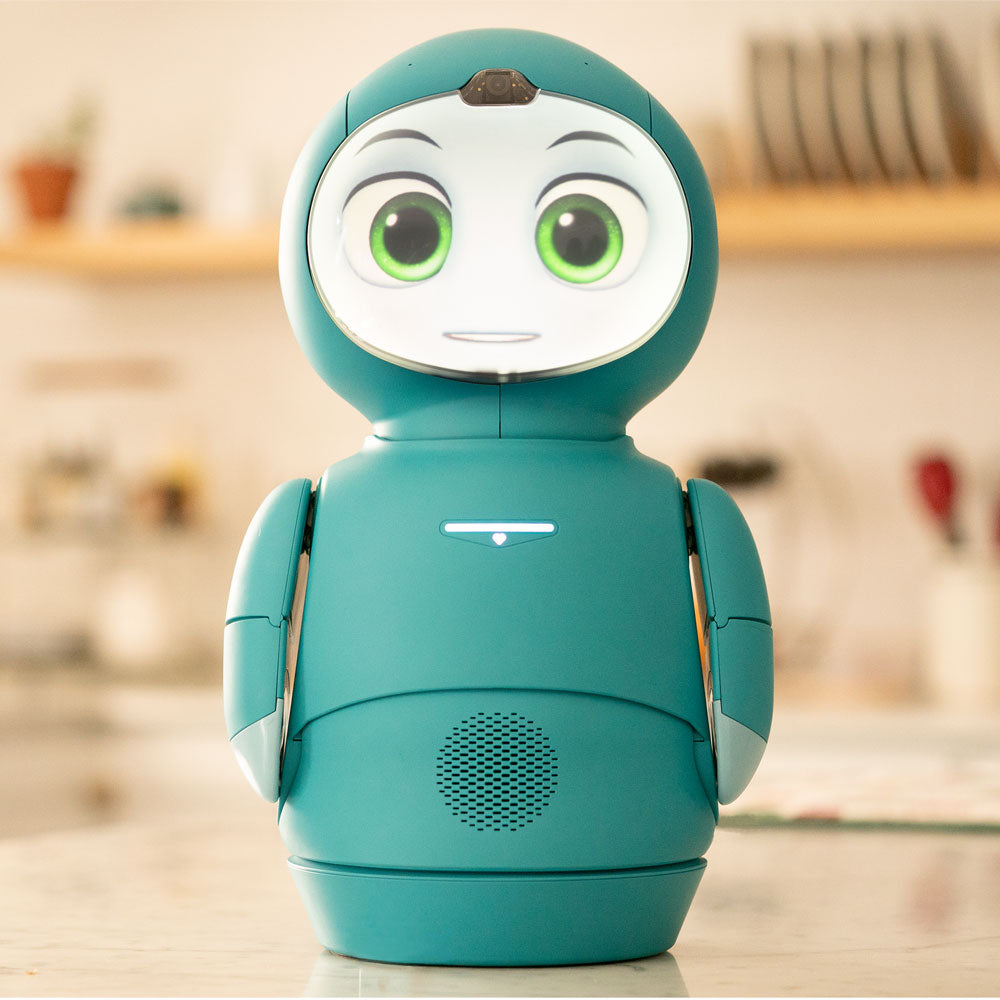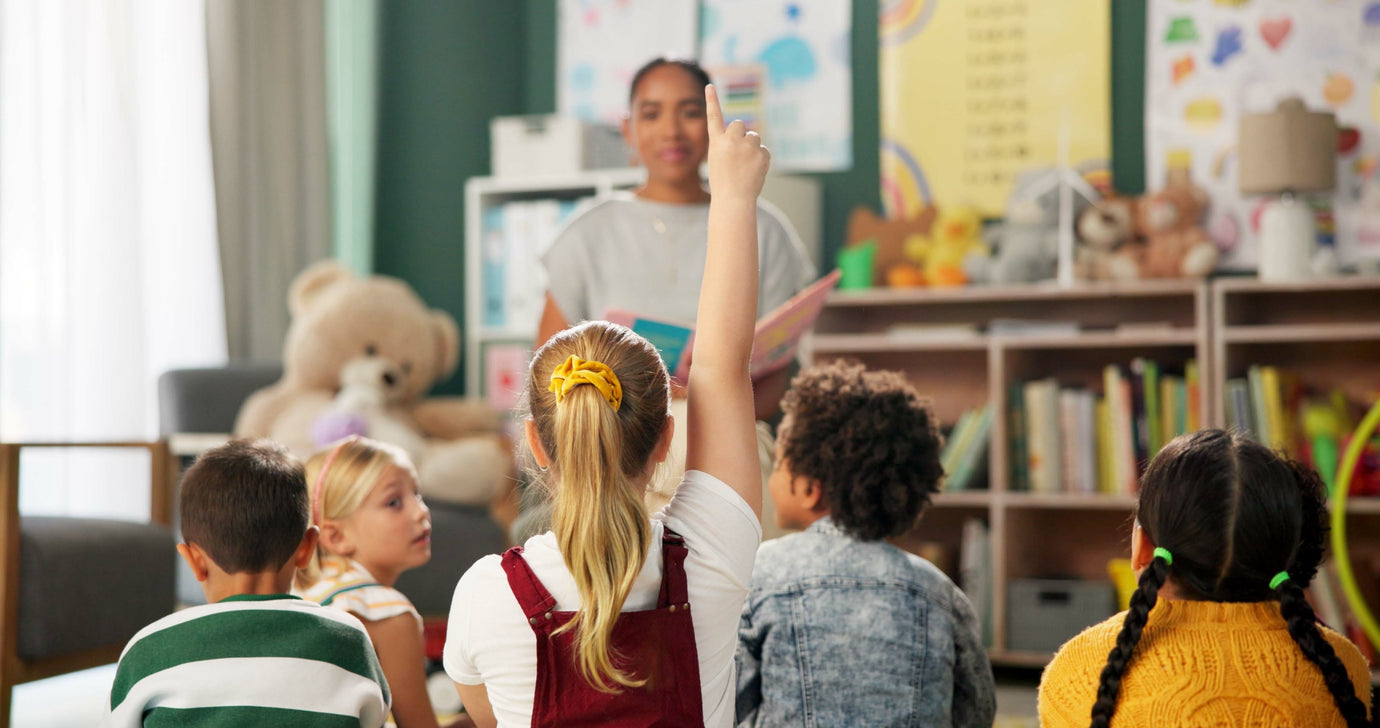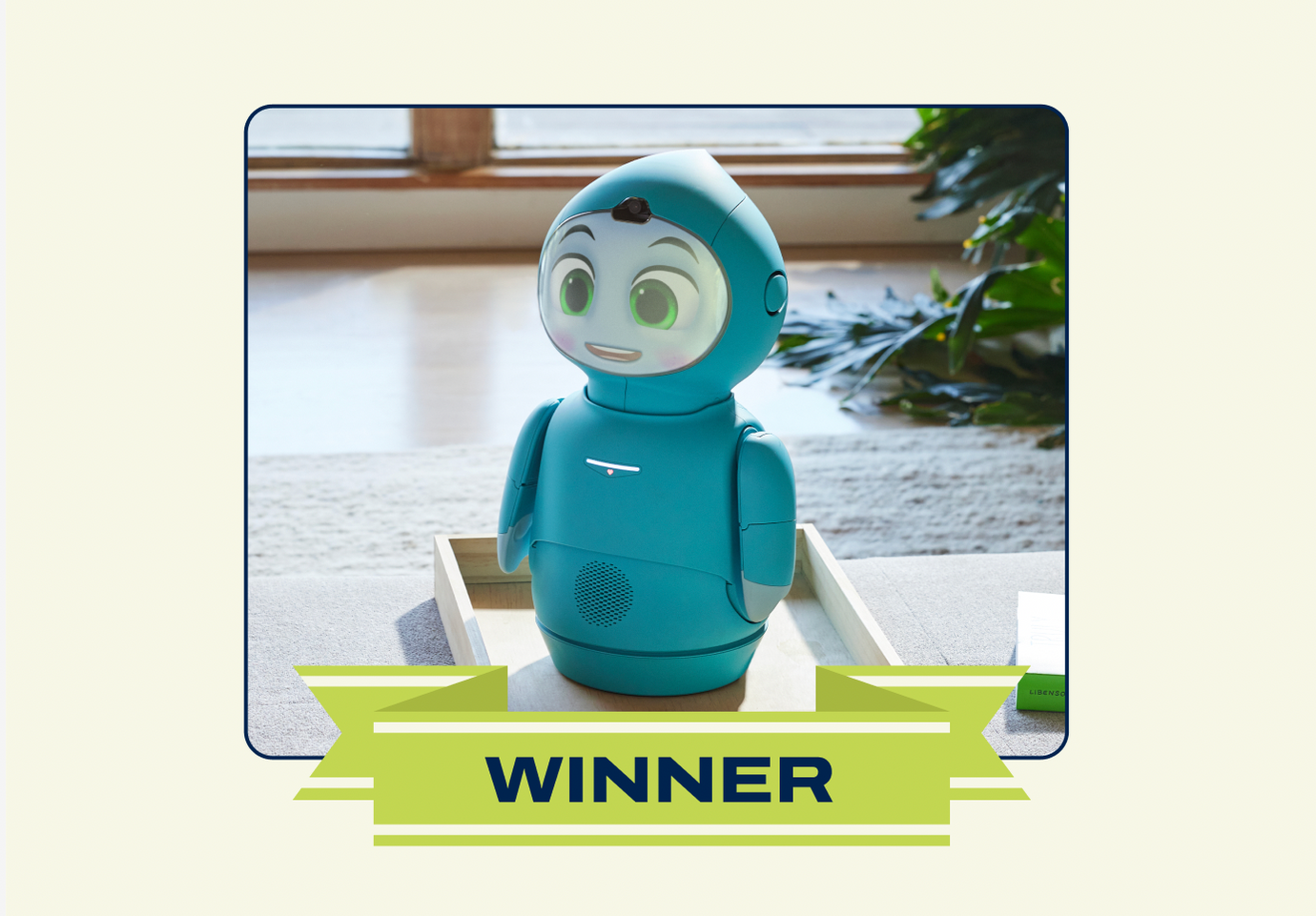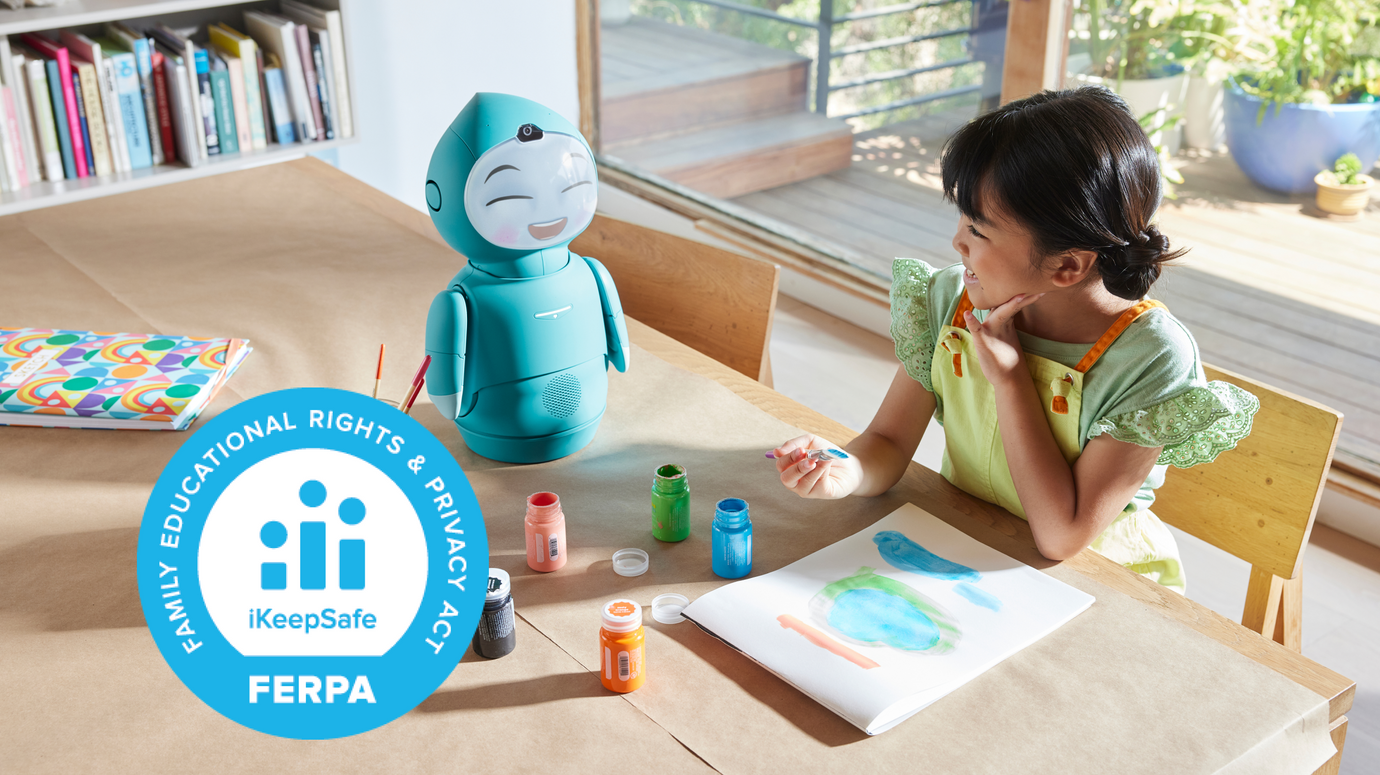The Science Behind Moxie

The Research Behind Moxie
At Embodied, our team of experts including engineers, roboticists, neuroscientists, child development specialists, and creative storytellers, have been working for the past several years to rethink and reinvent how we utilize human-machine interaction to fuel new ways of interacting and learning. Drawing on evidence-led science and our combined expertise, we’ve developed a new revolutionary robot to help children: Moxie.
Powered by our platform, SocialX™, Moxie is able to perceive, process and respond to natural conversation, eye contact, facial expressions and other behavior as well as recognize and recall people, places, and things to create a unique and personalized learning experience for your child. SocialX™ includes cloud-based software, software that is included in the parent App which is downloadable onto a user’s phone as well as software downloaded onto the robot Moxie.
SocialXChat™ is a part of our SocialX™ platform that stimulates conversations between the user and Moxie. It utilizes artificial intelligence to assist Moxie in replying verbally and non-verbally to questions from users who are interfacing with Moxie. SocialXChat™ includes cloud-based software, software that is included in the parent App which is downloadable onto a user’s phone, as well as software downloaded onto the robot.
Our state-of-the-art platform combined with content informed by best practices in child development, come together to create a revolution in learning for children.
How does a robot help with learning?

How does this compare with other ways of learning?
Looking across 65 studies comparing embodied agents (e.g. robots) vs. non-embodied agents. Robots significantly outperformed non-embodied agents in 78.5% of the studies:

This looked at both objective task performance AND user experience.
*See footnotes 1-6 for studies referenced
What else does research say?
Children like robots! Robots can engage and motivate children. They’ll anthropomorphize robots with life-like characteristics, states and rights.7 They form friendships and share thoughts.8,9 This type of engagement can help children with learning.

Numerous studies (over 12,500 peer-reviewed articles!) also show strong scientific evidence that robots can help children improve social skills.
*See footnotes 10-14 for studies referenced
So, I know my child will play with a robot, but what skills can my child learn?

*See footnotes 15-19 for studies referenced
Personalization of the interaction through machine learning and AI increases learning gains. Hear more from our expert on individualized interactions:
Any additional benefits to using robots?

*See footnotes 20-22 for studies referenced
So what research is there about Moxie specifically?
In our preliminary studies, we’ve found that interactions with Moxie may help children improve in developing social and emotional skills. We summarize the findings from these preliminary studies below, and will be expanding our research beyond these preliminary studies to further explore how robots like Moxie might help children in a range of abilities. Moxie is not a medical device, but is intended to help promote general social, emotional, and cognitive development through play-based learning.
Research summary:
In our first preliminary study, our on-staff Doctor of Occupational Therapy observed a group of children (twelve in total) who interacted with Moxie (3 times a week for 15 minutes) over a period of 6 weeks in the Spring of 2019. Assessments were made before and after their time with Moxie and improvements in key subjective and objective criteria used to evaluate the participating children were found in the following areas:


Based on this small, but encouraging, study, we then launched our Moxie Pioneer Mentor Program as a second preliminary study. To our knowledge, this is one of the largest studies to date in observing how a companion robot, like Moxie, can help promote social, emotional, and cognitive development among a neurodiverse group of children between the ages of 5-10. More than 50 families from across the country volunteered to participate in the program, with children spending time engaging in meaningful daily play with Moxie and parents providing ongoing feedback to the Embodied team. To explore Moxie’s impact on skill development, parents completed standardized assessments including the Social Skills Improvement System (SSIS)23 and the Social Responsiveness Scale (SRS-2)24. The SSIS evaluates social skills, problem behaviors, and academic competence, while the SRS-2 identifies the presence and severity of social impairment within the autism spectrum and differentiates it from that which occurs in other disorders. Assessments were completed one month prior to receiving Moxie, again right before Moxie arrived, and again after one month of interacting with Moxie. Confidential assessments were completed online and then scored and analyzed by our on-staff Doctor of Occupational Therapy.
A total of 51 families completed pre- and post-assessments and were included in our analysis. Findings indicate that after one month of interacting with Moxie:
- 71% of children made SOME improvement in social skills
- 50% of children made SIGNIFICANT improvement in social skills
- 69% of children made SOME improvement in behavior
- 49% of children made SIGNIFICANT improvement in behavior
- Neurotypical and Neurodiverse children improved equally on social skills
- Biggest areas of change: communication, social engagement, emotion regulation
“Some” improvement refers to a change of 1-4 points in social or behavioral skills from the baseline pre-arrival assessment to the final post-assessment score. “Significant” improvement refers to a change of 5 points or greater in social or behavioral skills using the same metrics. Anecdotally, many parents reported behavioral changes in their child since they first started engaging with Moxie. Changes included reports that children seemed to feel happier and less lonely, were better able to cope with their emotions and calm themselves down when upset, were more polite and helpful, expressed their thoughts and feelings more clearly, and exhibited greater interest in the thoughts and feelings of others.
We will be expanding our research beyond these preliminary findings to further explore how robots like Moxie might help children in a range of abilities. Moxie is not a medical device, but is intended to help promote general social, emotional, and cognitive development through play-based learning. The preliminary studies involved small sample sizes and may not be indicative of actual results. The results of a child’s interaction with Moxie may vary. Individual children may or may not directly benefit from interacting with Moxie and may not demonstrate any observable behavioral changes after using Moxie. Families were not compensated for their participation in our preliminary studies. For further details on our initial preliminary study, you can view our 2020 white paper which is available here.
Recently, Embodied also had the opportunity to partner with the Golisano Children’s Hospital at the University of Rochester Medical Center to explore Moxie’s use in a hospital setting. In 2022, we completed a successful pilot study showing that the use of Moxie is feasible in a pediatric hospital environment.
A total of 17 hospitalized pediatric patients interacted with Moxie during their hospital stay, with parents and patients providing feedback through questionnaires and members of the clinical care team measuring overall engagement using the validated Global Engagement Ratings scale.
Study findings showed the clinical care team was able to set up and run Moxie in a patient’s hospital room and train others to do so, pediatric patients were motivated and engaged in the Moxie interactions, and 100% of parents said they’d recommend Moxie to a friend. As one parent reported, "She really brightened up when Moxie came in."
References:
-
Lee, K. M., Jung, Y., Kim, J., & Kim, S. R. (2006). Are physically embodied social agents better than disembodied social agents?: The effects of physical embodiment, tactile interaction, and people's loneliness in human–robot interaction. International Journal of Human-Computer Studies, 64(10), 962-973.
-
Shahid, S., Krahmer, E., & Swerts, M. (2014). Child–robot interaction across cultures: How does playing a game with a social robot compare to playing a game alone or with a friend?. Computers in Human Behavior, 40, 86-100.
-
Jost, C., Le Pévédic, B., & Duhaut, D. (2012, September). Robot is best to play with human!. In RO-MAN, 2012 IEEE (pp. 634-639). IEEE.
-
Komatsu, T. (2010). Comparison an On-screen Agent with a Robotic Agent in an Everyday Interaction Style: How to Make Users React Toward an On-screen Agent as if They are Reacting Toward a Robotic Agent. In Human-Robot Interaction. InTech.
-
Kose-Bagci, H., Ferrari, E., Dautenhahn, K., Syrdal, D. S., & Nehaniv, C. L. (2009). Effects of embodiment and gestures on social interaction in drumming games with a humanoid robot. Advanced Robotics, 23(14), 1951-1996.
-
Leyzberg, D., Spaulding, S., Toneva, M., & Scassellati, B. (2012, January). The physical presence of a robot tutor increases cognitive learning gains. In Proceedings of the Annual Meeting of the Cognitive Science Society (Vol. 34, No. 34).
-
Turkle, Sherry, Cynthia Breazeal, Olivia Dasté, and Brian Scassellati. "Encounters with kismet and cog: Children respond to relational artifacts." Digital media: Transformations in human communication 120 (2006).
-
Beran, Tanya N., and Alejandro Ramirez-Serrano. "Can children have a relationship with a robot?." In International Conference on Human-Robot Personal Relationship, pp. 49-56. Springer, Berlin, Heidelberg, 2010.
-
Bethel, Cindy L., Matthew R. Stevenson, and Brian Scassellati. "Secret-sharing: Interactions between a child, robot, and adult." In Systems, man, and cybernetics (SMC), 2011 IEEE International Conference on, pp. 2489-2494. IEEE, 2011.
-
“Robots for Use in Autism Research”, Brian Scassellati, Henny Admoni, and Maja Mataric’, Annual Review of Biomedical Engineering, Vol 14:275-294, August 2012.
-
“The clinical use of robots for individuals with Autism Spectrum Disorders: A critical review”, by Joshua J.Diehl, Lauren M.Schmitt, Michael Villano, and Charles R.Crowell. In Research in Autism Spectrum Disorders, Volume 6, Issue 1, January–March 2012, Pages 249-262.
-
“Are Robots Ready to Deliver Autism Interventions? A Comprehensive Review”, by Momotaz Begum, Richard W. Serna, and Holly A. Yanco. International Journal of Social Robotics, Vol 8, Issue 2, 157-181, April 2016.
-
“Why Robots? A Survey on the Roles and Benefits of Social Robots in the Therapy of Children with Autism”, by John-John Cabibihan, Hifza Javed, Marcelo Ang Jr., and Sharifah Mariam Aljunied. International Journal of Social Robotics, Vol 5, Issue 4, 593-618, Nov 2013.
-
“A Survey of Expectations About the Role of Robots in Robot-Assisted Therapy for Children with ASD: Ethical Acceptability, Trust, Sociability, Appearance, and Attachment”, by Mark Coeckelbergh, Cristina Pop, Ramona Simut, Andreea Peca, Sebastian Pintea, Daniel David, Bram Vanderborght, Science and Engineering Ethics, Vol 22, Issue 1, 47-65, Feb 2016.
-
Kennedy, James, Paul Baxter, Emmanuel Senft, and Tony Belpaeme. "Social robot tutoring for child second language learning." In Human-Robot Interaction (HRI), 2016 11th ACM/IEEE International Conference on, pp. 231-238. IEEE, 2016.
-
Park, Hae Won, Rinat Rosenberg-Kima, Maor Rosenberg, Goren Gordon, and Cynthia Breazeal. "Growing growth mindset with a social robot peer." In Proceedings of the 2017 ACM/IEEE International Conference on Human-Robot Interaction, pp. 137-145. ACM, 2017.
-
Robins, Ben, Kerstin Dautenhahn, René Te Boekhorst, and Chrystopher L. Nehaniv. "Behaviour delay and robot expressiveness in child-robot interactions: a user study on interaction kinesics." In Proceedings of the 3rd ACM/IEEE international conference on Human robot interaction, pp. 17-24. ACM, 2008.
-
Baxter, Paul, James Kennedy, Tony Belpaeme, Rachel Wood, Ilaria Baroni, and Marco Nalin. "Emergence of turn-taking in unstructured child-robot social interactions." In Human-Robot Interaction (HRI), 2013 8th ACM/IEEE International Conference on, pp. 77-78. IEEE, 2013.
-
Gordon, Goren, Cynthia Breazeal, and Susan Engel. "Can children catch curiosity from a social robot?." In Proceedings of the Tenth Annual ACM/IEEE International Conference on Human-Robot Interaction, pp. 91-98. ACM, 2015.
-
Leite, Iolanda, Carlos Martinho, and Ana Paiva. "Social robots for long-term interaction: a survey." International Journal of Social Robotics 5, no. 2 (2013): 291-308.l
-
Leite, Iolanda, Ginevra Castellano, André Pereira, Carlos Martinho, and Ana Paiva. "Empathic robots for long-term interaction." International Journal of Social Robotics 6, no. 3 (2014): 329-341.
-
Jacq, Alexis D., Séverin Lemaignan, Fernando Garcia, Pierre Dillenbourg, and Ana Paiva. "Building successful long child-robot interactions in a learning context." In The Eleventh ACM/IEEE International Conference on Human Robot Interaction, pp. 239-246. IEEE Press, 2016.
-
Elliot, S. and Gresham, F. (2008). Social skills improvement system rating scales. Minneapolis, MN: NCS Pearson.
-
Bruni, T. P. (2014). Test review: social responsiveness scale–second edition (srs-2).






